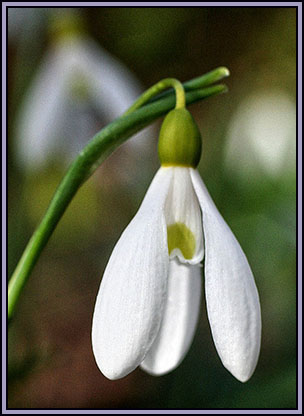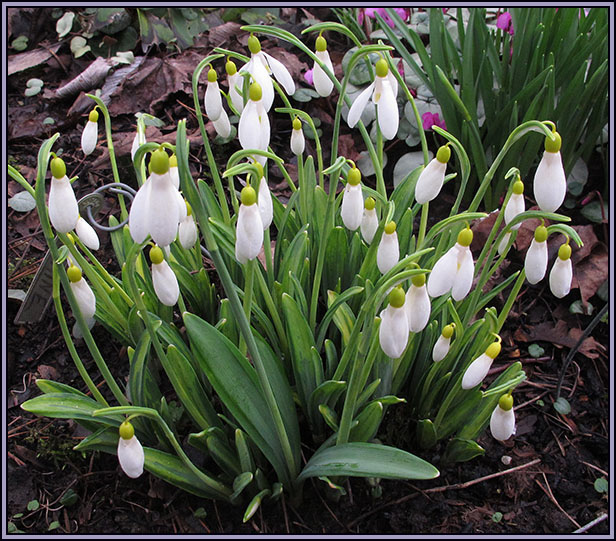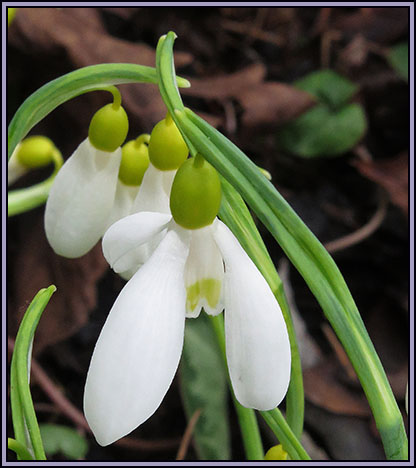|
It would be invidious to pick out one
snowdrop from the two gardens in Dublin visited
by the Ulster Group of the Alpine Garden Society
on 10th February2018. However one
that did take my eye was Galanthus
“Madeleine”.
There were at least two large clumps of this
flavescent (yellow) snowdrop close together,
indicating that it had probably been vigorous
enough to split (picture below). Luckily David
Ledsham was on hand. He also has G.
“Madeleine”
in his garden and he confirmed it was a good
“doer”.
|
 |
| Flavescence
in snowdrops has been known since at least 1877
when Rev. H. Harpur- Crewe was asked to identify
a G.
nivalis for a Mr. Sanders. The plants in
question had been collected in Northumberland.
Rev. Harpur-Crewe named them after Sanders G.
sandersii. There were many subsequent
collections in the years to come – all from
Vice County 68 (Cheviot). As they come from a
variable wild population they are now correctly
given a group name – G.
nivalis Sandersii Group. The population in
Cheviot has been studied by Beeston and Pitts,
undergraduates of Dr. John Richards at
University of Newcastle. They concluded that it
was genetically controlled (rather than a
virus). This gene however is also recessive.
|
|
|

|
Seed-set
in G. nivalis
is low as plants are self-incompatible. So yellow
snowdrops are rare and as such have been highly
desirable to collectors. Another aspect of the wild
population in Cheviot noted by Beeston was a lack of
vigour, with yellow plants occurring at the fringes of
their sturdier neighbours.
|
| Flavescence
probably occurs in all Galanthus
species. Over the years I have had several (all
cultivars of G. nivalis and G. plicatus).
Only G. plicatus
“Wendy’s Gold” and one of the Sandersii
Group have survived in my garden. I am sure this is
probably down to my own (lack of) skill as a
cultivator. It is not unusual however to see yellow
snowdrops given extra attention in even famous
gardens. One
solution is to grow them in sinks. A lot of cultivars
definitely lack vigour. A vigorous yellow snowdrop
would be a welcome addition to any collection.
|
|
| Galanthus
“Madeleine” was found as a chance seedling at Monksilver
– the nursery of Joe Sharman, and named for his
niece. It is a vigorous mid-season snowdrop with green
leaves. The intensity of the yellow varies according
to soil type.
|
 |
| As a footnote the most expensive snowdrop I
have heard of is also yellow and came from Joe Sharman's
nursery. Nearly all Galanthus
cultivars have arisen by chance. This is in marked
contrast to, for instance, Narcissus cultivars. In our own AGS Group Brian Duncan is an
exemplar daffodil breeder, deliberately crossing
plants and only naming the very best. G.
“Golden Fleece” is a cross between
“Wendy’s Gold” and “Trym” (both plicatus cultivars). When back-crossed to “Wendy’s Gold” the
recessive gene is given expression and the result is a
new yellow snowdrop. However it probably took a decade
to produce “Golden Fleece”.
|
|
| One daffodil breeder who was taking note
however was Anne Wright in Yorkshire. Already
experienced in making such crosses in Narcissus
she turned her attention in 2006 to Galanthus
Hand pollination of Wendy’s Gold and some of the
Sandersii Group gave her 20 seeds and she has grown
them on to produce the Dryad Gold Group of yellow
snowdrops. All attempts to recreate the cross have
been unsuccessful so they are all unique. You can see
more of these at The International Gardener (website
of Scottish Rock Garden Club) at
http://www.srgc.org.uk/logs/logdir/2015Jun251435252604IRG_66.pdf
There are also far more yellow snowdrops than
I ever imagined, I suppose as galanthophilia has
spread to the Continent. A recent stream http://www.srgc.net/forum/index.php?topic=15063.0 on the Scottish Rock Garden Club website
named about 140, which truly staggered me.
|
|
So
the future of yellow snowdrops seems assured as we no
longer have to rely on chance finds. They will remain
however highly desirable and you will require a deep
pocket and eBay to fulfil your desires.
I
would like to thank David Ledsham for all his help and
comments, and for the photographs taken in his garden.
|
|
|
|
|
|
